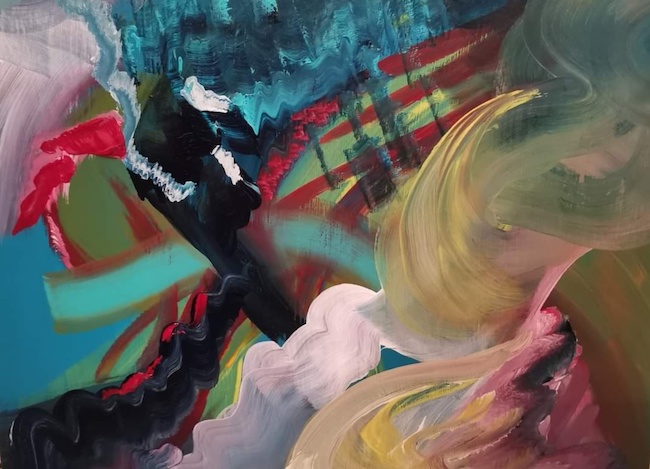Molto spesso gli artisti contemporanei tendono a concentrarsi sugli aspetti più esplorativi, nebbiosi, di una realtà difficile da comprendere quanto a volte da vivere, inducendo così le loro sensibilità a soffermarsi su tutto quanto normalmente resta nascosto proprio a causa della predisposizione dell’uomo di oggi a restare in superficie per non spaventarsi per le paure e le ansie da cui altrimenti resterebbe sopraffatto. L’artista di cui vi parlerò oggi invece mostra un approccio solare, positivo, in virtù del quale, pur scegliendo di approfondire, osservare ed esplorare il suo mondo interiore, dimostra quanto un punto di vista differente possa comunque essere comunicativo e perfettamente calato nella realtà contemporanea.
Il mondo delle emozioni forti, quelle gridate di cui gli innovatori di fine Ottocento e dei primi anni del Novecento hanno reclamato il diritto di fuoriuscire da un’opera d’arte, è stato costantemente messo in secondo piano nella pittura tradizionale perché ciò che doveva prevalere era l’attinenza alla realtà osservata, la perfezione dei particolari e la fedeltà a ciascuno dei dettagli narrati sulla tela; a partire dai concetti forti dei Fauves in avanti invece si era sovvertito l’ordine di priorità dimostrando perciò che la forma era secondaria rispetto alla sostanza e soprattutto all’intensità del percepito. Ciò che colpì in particolar modo di quei primi esperimenti di affrancamento dalle regole accademiche fu proprio l’uso del colore in completa dissociazione dall’osservato ma in totale affinità con il pulsare di quelle emozioni che spingevano l’artista a lasciarsi andare liberamente senza doversi attenere a schemi e gabbie che avrebbero limitato l’impulso creativo. Dalle opere variopinte ma mai cupe di Henri Matisse e di André Derain si giunse poco dopo all’Espressionismo che mostrò però uno sguardo più esistenzialista che lasciava emergere le ansie, le angosce, la mancanza di certezze del periodo instabile tra gli anni Venti e gli anni Quaranta del Novecento a cui si affiancò anche un nuovo modo di intendere l’arte, quello dell’Astrattismo. I primi movimenti di distacco dalla forma conosciuta si orientarono anche verso un altrettanto forte rifiuto del mondo emotivo, della soggettività dell’artista poiché l’opera doveva prescindere da ogni sentimento, da qualsiasi riferimento esistente proprio per dimostrare la superiorità dell’arte sulle alternative forme di riproduzione dell’immagine come la fotografia. La completa estraneità del mondo emozionale, che trovò la sua piena realizzazione nel Neoplasticismo, nell’Astrattismo Geometrico e in tutte le correnti avanguardiste del Concettualismo, dello Spazialismo, del Cubismo Orfico, incorsero però nel medesimo ostacolo, quello di non riuscire a coinvolgere l’osservatore che, a meno che non appartenesse a una ristretta cerchia di intellettuali in grado di comprendere il messaggio di questi movimenti pittorici, non capiva la freddezza di quelle opere. Fu solo con l’Espressionismo Astratto, privo di ogni regola stilistica ed esecutiva proprio perché i suoi fondatori erano convinti che esclusivamente attraverso la libertà fosse possibile permettere agli artisti di esprimere quel mondo interiore che non doveva dunque più essere trattenuto; e fu grazie a quel gruppo di coraggiosi in grado di scrivere una pagina nuova nella storia dell’arte moderna, che i contemporanei hanno potuto scegliere a loro volta la libertà di essere artisticamente ciò che sentono di voler essere, sperimentando, contaminando, mescolando stili del passato per trovare la propria strada espressiva. L’artista ceca Lenka Ruvolo mostra quanto sia importante la scelta cromatica, e dunque non solo quella stilistica, per mostrare il proprio punto di vista sulla vita, uno sguardo sorridente e solare che le permette di raccontare all’osservante quanto non sia necessario andare a scavare nelle angosce e nelle sensazioni negative per mostrare la profondità emozionale.
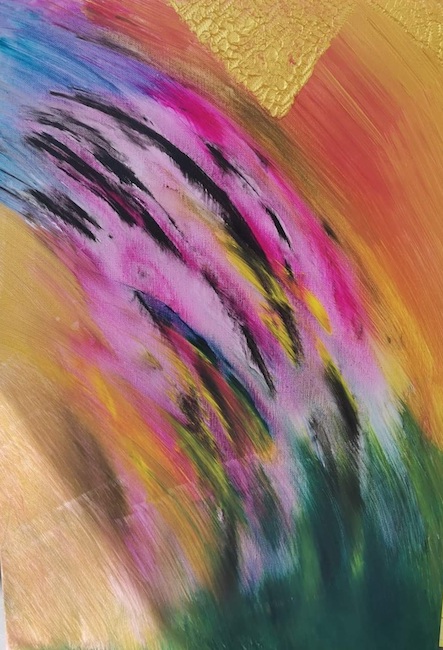
Tutt’altro, in lei ogni pensiero, ogni elemento dell’attuale esistenza, corrisponde a un’opportunità, una scelta di positività, la capacità di vedere il lato luminoso della vita piuttosto che soffermarsi sulle ombre.
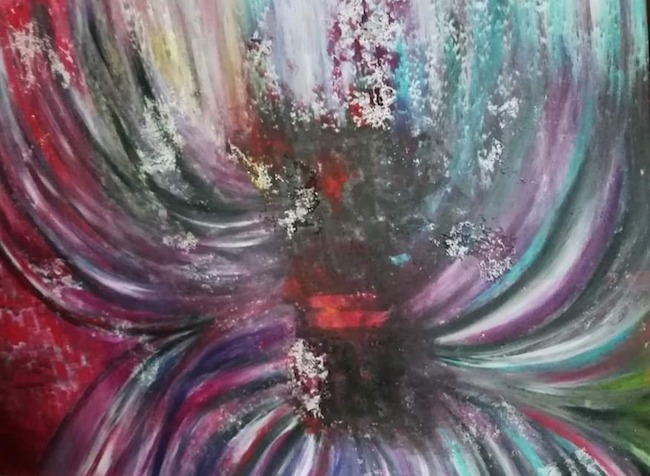
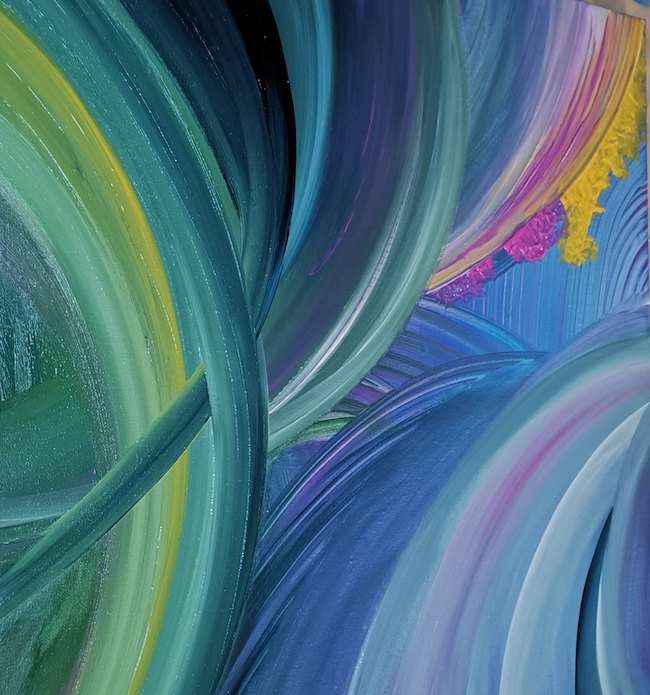
L’Espressionismo Astratto di cui la Ruvolo si avvale per dare vita alle sue opere si manifesta con tonalità piene, intense, vitali, molto vicine a quelle del Cubismo Orfico di Delaunay o a quelle utilizzate da Hans Hoffman per il suo tachisme in cui i forti contrasti e la positività fuoriuscivano e travolgevano l’osservatore; nell’artista ceca ciò che conta è esplorare attraverso il proprio filtro emozionale e interiore tutte le sensazioni che accompagnano il percorso di vita di ciascuno, tutto quel ventaglio di sogni, speranze, timori in grado di indurre l’individuo a riflettere e a scegliere l’approccio di cui avvalersi per osservare e procedere nel proprio cammino. Lenka Ruvolo sceglie quello ottimista, quello in cui viene osservata la metà migliore delle cose e non quella peggiore, e lo fa suggerendo velatamente al fruitore quanto sia più piacevole riuscire a vedere i colori più vivaci piuttosto che puntare l’attenzione sulle scale di grigi; la tela Můj svět (Il mio mondo) racconta di quei legami forti che arricchiscono la sua quotidianità, quella capacità di sentirsi all’interno di un’armonia esistenziale in cui anche le tonalità fredde come gli azzurri e i verdi possono assumere un’accezione calda, morbida, rassicurante e sognante, proprio in virtù della particolare capacità dell’artista di prendere come un dono tutto ciò che arriva, certa che sia la cosa migliore per lei e di conseguenza restituire a chi fa parte della sua vita il medesimo calore.
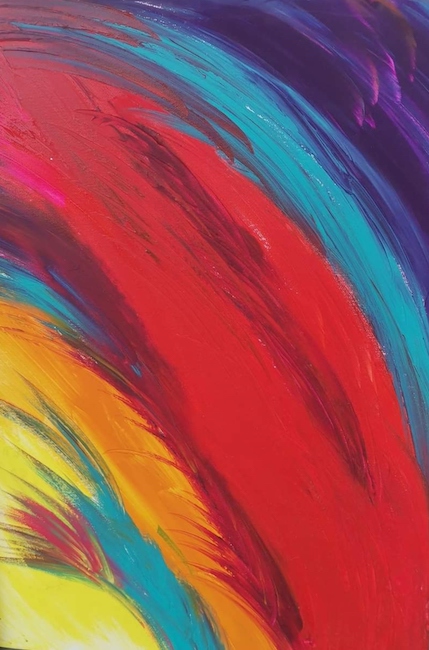
In Hojnost (Abbondanza) le tonalità si fanno più intense, più vivaci, come se l’opera raffigurasse un arcobaleno di opportunità, di possibilità che si presentano davanti agli individui e che aspettano solo di essere considerate e colte, guardate in tutte le loro sfaccettature e intensità; quest’opera è un’esortazione da parte della Ruvolo a non lasciarsi intimorire dalle decisioni, a non temere di compiere un cambiamento che può apparire come un salto nel buio perché è solo aprendosi con fiducia ai nuovi percorsi che si riesce a socchiudere la porta a tutto ciò che può entrare nella vita e che la può arricchire, migliorare e incrementare, se si riesce a vedere il risvolto positivo di ogni accadimento. La gamma cromatica passa dal giallo all’arancione, al rosso e poi al viola, colori della gioia, della vitalità, dell’intensità emozionale per finire ai più intimisti che rappresentano l’anima, quel mondo interiore che si realizza pienamente nel momento in cui vengono accolte tutte le sensazioni precedenti.
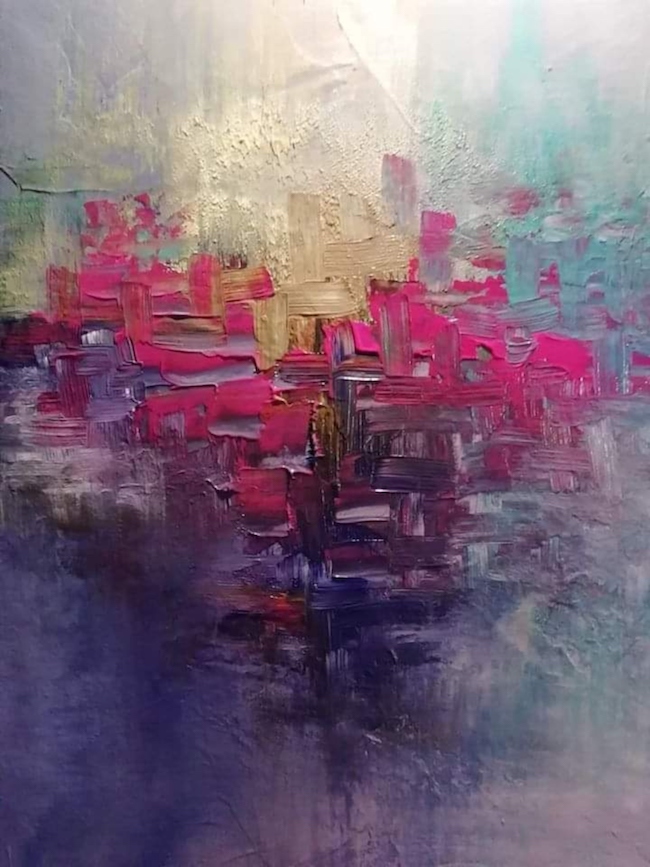
Ma le opere di Lenka Ruvolo a volte si fanno più interiori, più riflessive e meditative, proprio perché in alcuni casi è necessario fermarsi e ascoltare con attenzione i percorsi più profondi, e dunque emerge un bisogno di silenzio, di raccoglimento, di atmosfera in cui non viene dimenticata la piacevolezza delle emozioni piuttosto il racconto necessita di un ritmo più lento, più suggestivo; questo tipo di approccio emerge nella tela Srdce (Cuore), dalla quale si sprigiona tutto l’incanto di un organo, ma figurativamente un luogo, in cui sono conservati i sentimenti forti, rassicuranti, solidi, in grado di cambiare la vita delle persone e il senso della stessa esistenza. Qui dunque le tonalità sono tenui, cipriate nello sfondo mentre la parte centrale dell’opera, quel cuore di cui parla il titolo, è rappresentato con pennellate dense ma brevi, come a costituire un reticolo di sensazioni, di persone, di eventi che ne costruiscono la stessa sostanza e che convivono per renderlo pulsante.
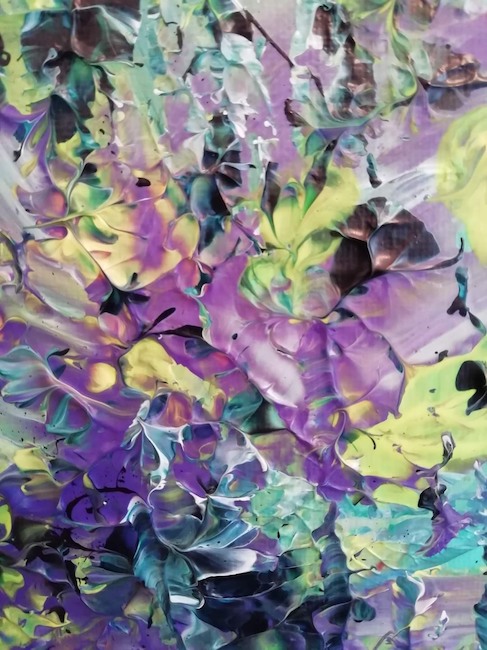
Ma l’attenzione della Ruvolo è spesso attratta anche dalla delicatezza dei fiori, della loro discreta eppure indispensabile presenza nel mondo della natura così come in quello delle case delle persone che hanno bisogno di attingere alla loro piacevolezza per ricordarsi di apprezzare le cose semplici, di ammirare i loro colori, a volte delicati a volte più intensi, per imparare ad ascoltare anche le voci più impercettibili, scorgendo la bellezza anche quando non completamente evidente, come nell’opera Zrcadlení (Specchiare).
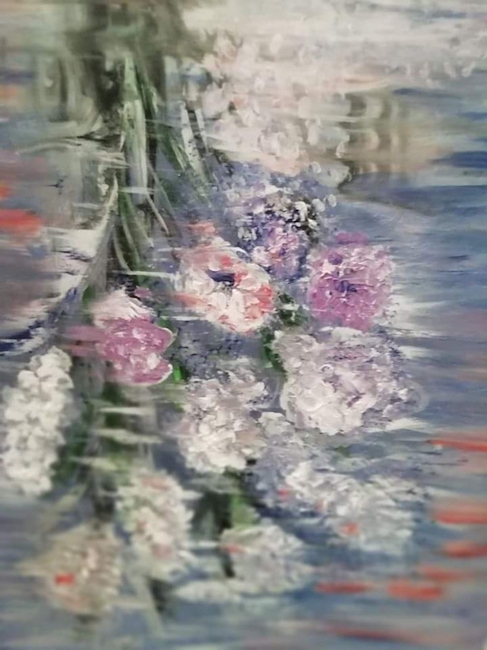
Lenka Ruvolo coltiva la sua forte inclinazione artistica parallelamente alla sua professione medica, eppure le sue opere sono state notate e apprezzate nell’ambiente artistico internazionale e da un pubblico di collezionisti che ama avere in casa l’armonia positiva delle sue tele.
LENKA RUVOLO-CONTATTI
Email: L.Kyvirova@seznam.cz
Facebook: https://www.facebook.com/lenka.kyvir
https://www.facebook.com/lenkakyvirova/
Lenka Ruvolo’s vivid and bursting tones of Abstract Expressionism, to tell a sunny emotional world
Very often contemporary artists tend to focus on the more exploratory, foggy aspects of a reality that is as difficult to understand as it is to experience, thus inducing their sensibilities to dwell on all that normally remains hidden precisely because of the predisposition of today’s man to remain on the surface so as not to be frightened by the fears and anxieties that would otherwise overwhelm him. The artist I am going to talk about today, on the other hand, shows a sunny, positive approach, by virtue of which, while choosing to delve into, observe and explore her inner world, she demonstrates how a different point of view can still be communicative and perfectly suited to contemporary reality.
The world of strong emotions, those shouted once of which the innovators of the late 19th and early 20th century claimed the right to get out of a work of art, has beeb was constantly sidelined in traditional painting because what had to prevail was the relevance to the reality observed, the perfection of the details and fidelity to each of the particulars narrated on the canvas; from the strong concepts of the Fauves onwards, however, the order of priorities was subverted, demonstrating that form was secondary to substance and above all to the intensity of perceived. What was particularly striking about those early experiments in breaking free from academic rules was precisely the use of colour in complete dissociation from the observed but in total affinity with the pulsing of those emotions that drove the artist to let himself go freely without having to adhere to schemes and cages that would have limited the creative impulse. From the colorful but never gloomy artworks of Henri Matisse and André Derain, shortly afterwards emerged Expressionism, which however showed a more existentialist gaze that let emerge the anxieties, anxieties, lack of certainties of the unstable period between the 1920s and the Forty of the twentieth century which was also joined by a new way of understanding art, that of Abstractionism.
The first movements of detachment from the known form were also oriented towards an equally strong rejection of the emotional world, of the subjectivity of the artist, since the work had to disregard any feeling, any existing reference precisely to demonstrate the superiority of art over alternative forms of image reproduction such as photography. The complete extraneousness of the emotional world, which found its full realisation in Neoplasticism, in Geometric Abstractionism and in all the avant-garde currents of Conceptualism, Spatialism and Orphic Cubism, however, ran into the same obstacle, that of failing to involve the observer who, unless he belonged to a restricted circle of intellectuals capable of comprehending the message of these pictorial movements, did not understand the coldness of these artworks. It was only with Abstract Expressionism, devoid of all stylistic and executive rules precisely because its founders were convinced that only through freedom was it possible to allow artists to express that inner world that no longer needed to be held back; and it was thanks to that group of courageous capable of writing a new page in the history of modern art, that contemporaries are able to choose in turn the freedom to be artistically what they felt they want to be, experimenting, contaminating, mixing styles from the past to find their own expressive path.
The Czech artist Lenka Ruvolo shows how important the choice of colour is, and therefore not only the stylistic choice, to show her own point of view on life, a smiling, sunny gaze that allows her to tell the observer how it is not necessary to dig into anguish and negative feelings to show emotional depth. On the contrary, in her every thought, every element of the present existence, corresponds to an opportunity, a choice of positivity, the ability to see the bright side of life rather than dwelling on the shadows. The Abstract Expressionism that Ruvolo uses to give life to her artworks manifests itself in full, intense, vital tones, very close to those of Delaunay’s Orphic Cubism or to those used by Hans Hoffman for his tachisme in which the strong contrasts and positivity come out and overwhelm the observer; for the Czech artist, what counts is to explore, through his own emotional and interior filter, all the sensations that accompany the path of life of each of us, all that range of dreams, hopes, fears that can induce the individual to reflect and choose the approach to be used to observe and proceed along his path. Lenka Ruvolo chooses the optimistic one, the one in which is observede the better half of things and not the worse half, and she does so by subtly suggesting to the viewer how much more pleasant it is to be able to see the brightest colours rather than focusing on the grey scale; the canvas Můj svět (My World) tells of the strong ties that enrich her everyday life, of her ability to feel part of an existential harmony in which even cold tones such as blues and greens can take on a warm, soft, reassuring and dreamy meaning, precisely because of the artist’s particular ability to take everything that comes her way as a gift, certain that it is the best thing for her and consequently to return the same warmth to the loved ones in her life.
In Hojnost (Abundance) the tones become more intense, more vivid, as if the painting depicted a rainbow of opportunities, of possibilities that present themselves to individuals and that are just waiting to be considered and grasped, looked at in all their facets and intensity; this artwork is an exhortation by Ruvolo not to be intimidated by decisions, not to be afraid of making a change that may seem like a leap in the dark, because it is only by confidently opening up to new paths that one can ajar the door to everything that may enter one’s life and enrich, improve and increase it, if one can see the positive side of every event. The range of colours goes from yellow to orange, red and then purple, colours of joy, vitality, emotional intensity, to the more intimate ones that represent the soul, that inner world that is fully realised when all the previous sensations are welcomed. But Lenka Ruvolo’s works sometimes become more interior, more reflective and meditative, precisely because in some cases it is necessary to stop and listen attentively to the most profound paths, and so there emerges a need for silence, for recollection, for an atmosphere in which the pleasantness of the emotions is not forgotten, rather the story needs a slower, more evocative rhythm; this type of approach emerges in the canvas Srdce (Heart), which releases all the enchantment of an organ, but also figuratively a place, where strong, reassuring, solid feelings are preserved, capable of changing people’s lives and the meaning of existence itself. Here, therefore, the tones are soft, powdery in the background, while the central part of the canvas, that heart of which the title speaks, is represented with dense but brief brushstrokes, as if to constitute a network of sensations, of people, of events that build up the same substance and coexist to make it pulsate. But Ruvolo’s attention is also often attracted by the delicacy of flowers, by their discreet yet indispensable presence in the world of nature as well as in the homes of people who need to draw on their pleasantness to remember to appreciate simple things, to admire their colours, sometimes delicate sometimes more intense, to learn to listen to even the most imperceptible voices, seeing beauty even when it is not completely evident, as in the work Zrcadlení (Specchiare). Lenka Ruvolo cultivates her strong artistic inclination in parallel with her medical profession, yet her artworks have been noticed and appreciated in the international art scene and by a public of collectors who love to have the positive harmony of her canvases in their homes.


